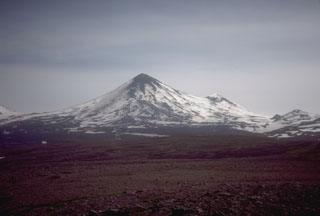Report on Pavlof (United States) — 6 October-12 October 2021
Smithsonian Institution / US Geological Survey
Weekly Volcanic Activity Report, 6 October-12 October 2021
Managing Editor: Sally Sennert.
Please cite this report as:
Global Volcanism Program, 2021. Report on Pavlof (United States) (Sennert, S, ed.). Weekly Volcanic Activity Report, 6 October-12 October 2021. Smithsonian Institution and US Geological Survey.
Pavlof
United States
55.417°N, 161.894°W; summit elev. 2493 m
All times are local (unless otherwise noted)
AVO reported that seismicity at Pavlof remained elevated during 6-12 October. Two explosions were recorded by infrasound network during 6-7 October. Mostly cloudy conditions obscured satellite and webcam images most days. The Volcano Alert Level and Aviation Color Code remained at Watch and Orange, respectively.
Geological Summary. The most active volcano of the Aleutian arc, Pavlof is a Holocene stratovolcano that was constructed along a line of vents extending NE from the Emmons Lake caldera. Pavlof and Pavlof Sister to the NE form a dramatic pair of symmetrical, glacier-covered stratovolcanoes that overlook Pavlof and Volcano bays. Little Pavlof is a smaller cone on the SW flank of Pavlof volcano, near the rim of Emmons Lake caldera. Unlike Pavlof Sister, eruptions have frequently been reported from Pavlof, typically Strombolian to Vulcanian explosive eruptions from the summit vents and occasional lava flows. The active vents lie near the summit on the north and east sides. The largest recorded eruption took place in 1911, at the end of a 5-year-long eruptive episode, when a fissure opened on the N flank, ejecting large blocks and issuing lava flows.
Source: US Geological Survey Alaska Volcano Observatory (AVO)

